
Beginner RVer Gear: Must-Have Tools & Helpful Accessories
Beginner RVer Gear: Must-Have Tools & Helpful Accessories
What do you need to bring with you for a successful RV trip?
By: Kelly Laustsen & David Somach
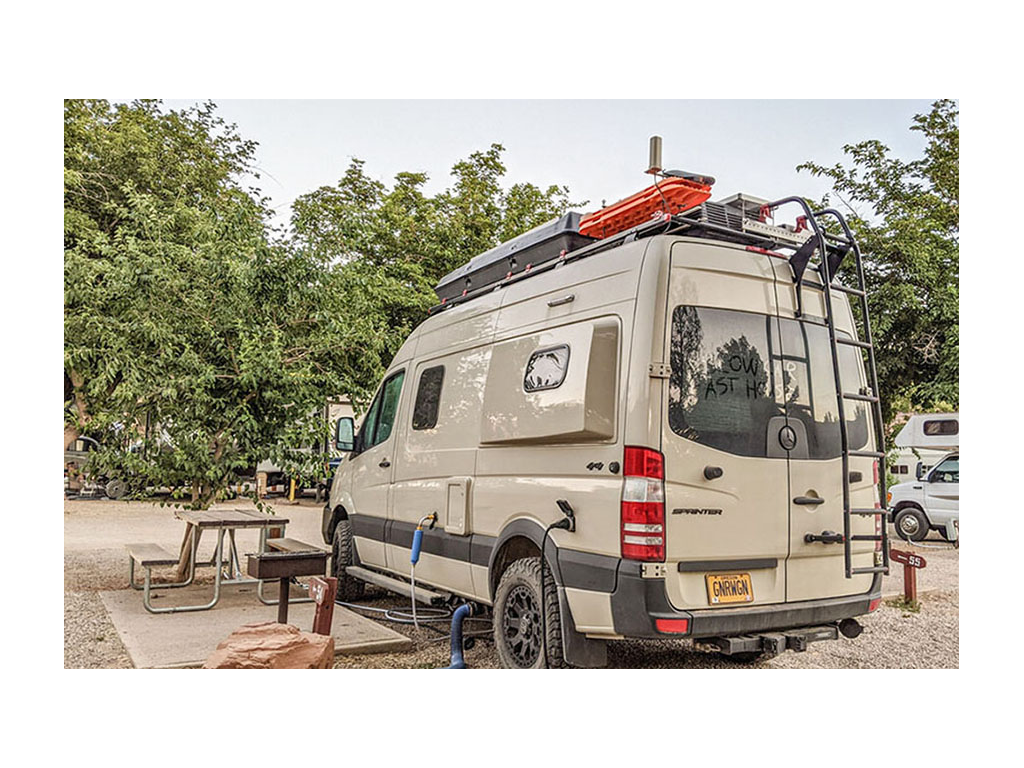
David’s grandfather used to say there is no such thing as bad weather, there is just bad gear. As Pacific Northwesterners used to cold and rain, we don’t like to let the elements stop us from getting out and having fun. We apply this same philosophy to our van and believe proper preparation is the key to a good trip – whether it is a weekend adventure or a year-long trip, like we recently took in our Winnebago Revel.
We are avid researchers and spent years perusing blogs and forums to get input on the essential tools and gadgets we’d need to outfit our van, wanting to hit the right balance of having what we’d need without overloading the van or breaking our budget.
After owning our van for a few years and using it for both short and long trips, we’ve compiled a list of the most important gear for first-time RVers. We’ve also included some extras that certainly aren’t required, but that we have in our arsenal of gear. The brands of gear we mention below are recommendations from our experience and not officially endorsed by Winnebago or any other company.
RVing Must Haves
The most important skills to gain as an RV newbie include filling the water tank, emptying the grey/black tanks, and monitoring the battery and power use. We were intimidated at first by the systems in the van, but quickly got comfortable keeping an eye on our water tanks and emptying our grey tank and cassette toilet in record speed. Below is the gear we think everyone should have for basic RV traveling.
Gear for Using Water
We can fill our Winnebago Revel’s water tank either by connecting to a drinking/potable water hose or through a gravity fill.
For the hose fill, we carry:
- 25-foot drinking/potable water hose: This has been long enough for us even in parks, truck stops, friends’ houses, or at other less-typical water filling locations.
- Pressure regulator: Ensures the water isn’t entering the van at too high of a pressure, which could cause damage to interior plumbing.
- Shutoff valve: We screw this on at the entry to the van, so we can watch for when the tank starts to overflow under the van and immediately shut the water off. We also get a read out in the van when the tank is full.
- Water filter: We use a Camco water filter which is supposed to remove chlorine and sediment in addition to making the water taste better. We only fill our tank with potable water, but have found that campground water often has a chlorine or plastic taste we think the filter helps remove.
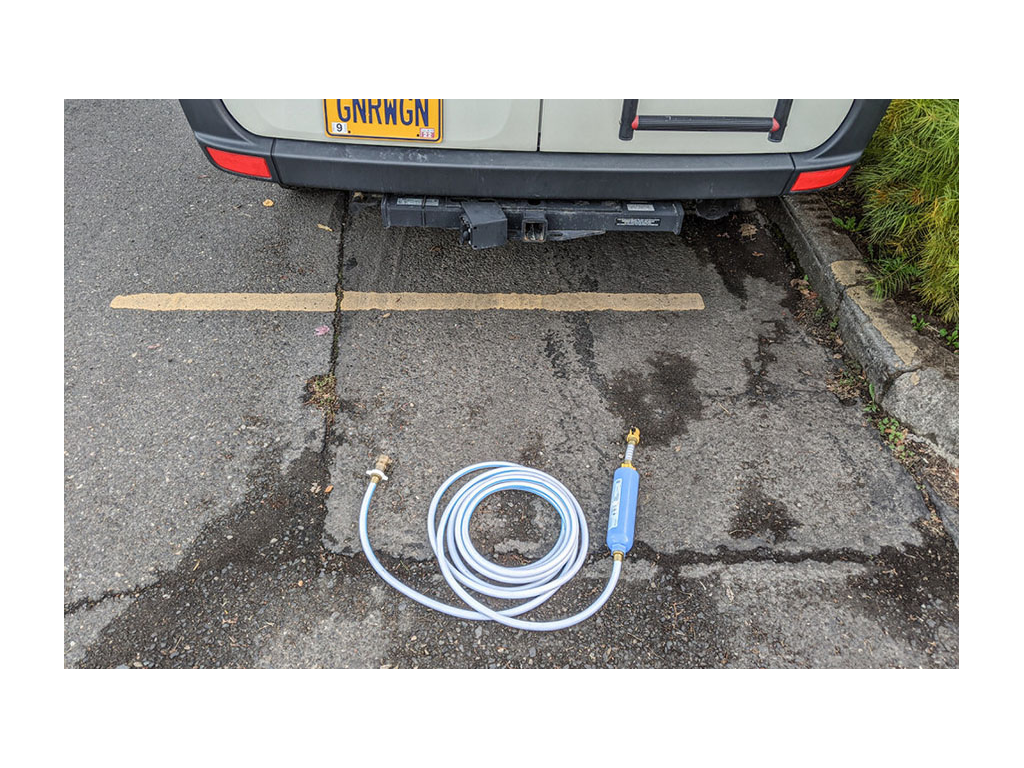
For the gravity fill, we have a five-gallon jug and funnel we use. We primarily use the gravity fill if we can’t find a faucet with a hose connection and just want to add a small amount of water to the tank through a water fountain or sink. Typically, we keep the five-gallon jug full to have on hand as extra drinking water. This allows us to go a little longer between water fills and provides a nice safety net if we plan to go off the grid for a few days.
Gear for Grey/Black Tanks
RVs vary when it comes to tanks, but at minimum, you will need a sewer hose.
Our van came equipped with a “stinky slinky” for emptying the grey tank. Our cassette toilet is removed from the side of the van and emptied at a dump station or in a toilet.
We think that dealing with the grey/black tanks is likely a deterrent for a lot of would-be RVers, but don’t think it needs to be! We carry a pair of reusable plastic gloves and large container of hand sanitizer that fits in our door cupholder. To keep things extra fresh, we put deodorizer tabs in our cassette toilet that are specific to our toilet manufacturer.
One thing we didn’t think to do for the first year we owned our RV was any toilet maintenance. We then realized it is recommended to lubricate the seal in our toilet and clean the cassette with a special solution a couple times a year, again with products specific to our toilet. We’d suggest checking into RV-specific maintenance for your tanks to make sure you keep your waste systems working well.
Gear for Using Power
While some RVs are equipped to run off of solar or other off-grid power sources for days at a time, at some point you will likely need to plug in. Here are some essentials we recommend having for that:
- Power cord: Our van uses a 30-amp hookup, so we always carry a short 30-amp power cord.
- Extension cord: We also carry a 50-foot extension cord in case the short cable can’t reach a power outlet in a friend’s driveway or at a campground.
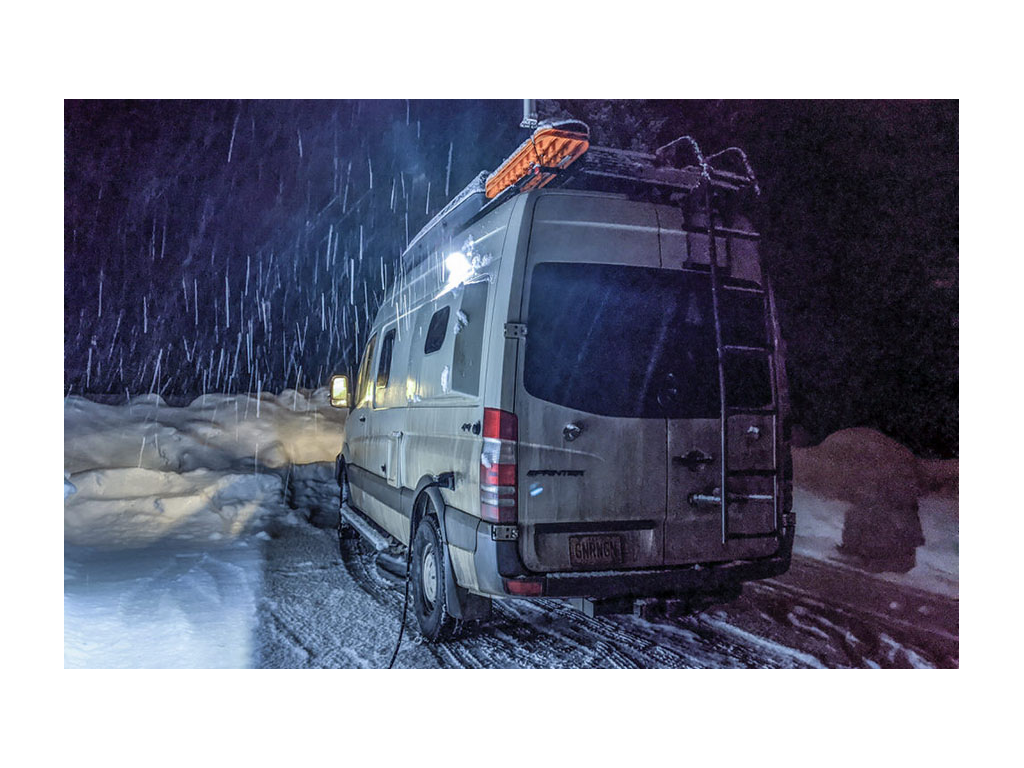
- Adaptor: We have a 30-amp to 15-amp dogbone electrical adaptor, which allows us to plug into a standard outlet, like in our driveway or at a friend’s house. However, when we are plugged into a 15-amp circuit, we have to keep an eye on our electricity usage, so we don’t overload the circuit and trip a breaker.
- Energy Monitoring System: The last thing we carry is a 30-amp Energy Monitoring System (EMS), which protects the van’s electronics from surges, open ground, and other potential problems from an unknown power source. We always use this when plugging in the van, just in case. We hope this isn’t necessary at campgrounds or RV parks, where the power source is likely reliable. However, we like to be on the safe side and the EMS gives us piece of mind, although it is one of the more expensive and bulky items we carry.
Safety Gear
We’d suggest carrying some basic safety gear in your RV, like a first aid kit, fire extinguisher, and LED flare lights. In addition, we have the following (some of which are more specific to our travel style):
- Dash camera: We use a dash cam in all of our vehicles in case of a crash, as unfortunately, we’ve experienced a hit and run in the past. Hopefully, we’ll never have to use the video footage from our van, but we think a dash cam is well worth the cost and simple install required. While our camera just records the road, we’ve also considered options that have an interior facing camera that can be activated when we have the van parked in case of a break-in.
- Winter tires: We use our van year-round and, in the winter, frequently make trips up to our local mountain. For anyone planning on doing snow driving, we’d suggest a set of snow tires as we think they make a huge difference in terms of traction and braking. (See our other winter Winnebago Revel gear suggestions).
- Tow strap: Our van is equipped with an expedition bumper and winch, so we are super prepared to rescue ourselves from any sticky situation should we ever get stuck. However, we’ve most often used our winch to rescue other vehicles! We suggest at the very least carrying a tow strap so that another vehicle can help if you get stuck.
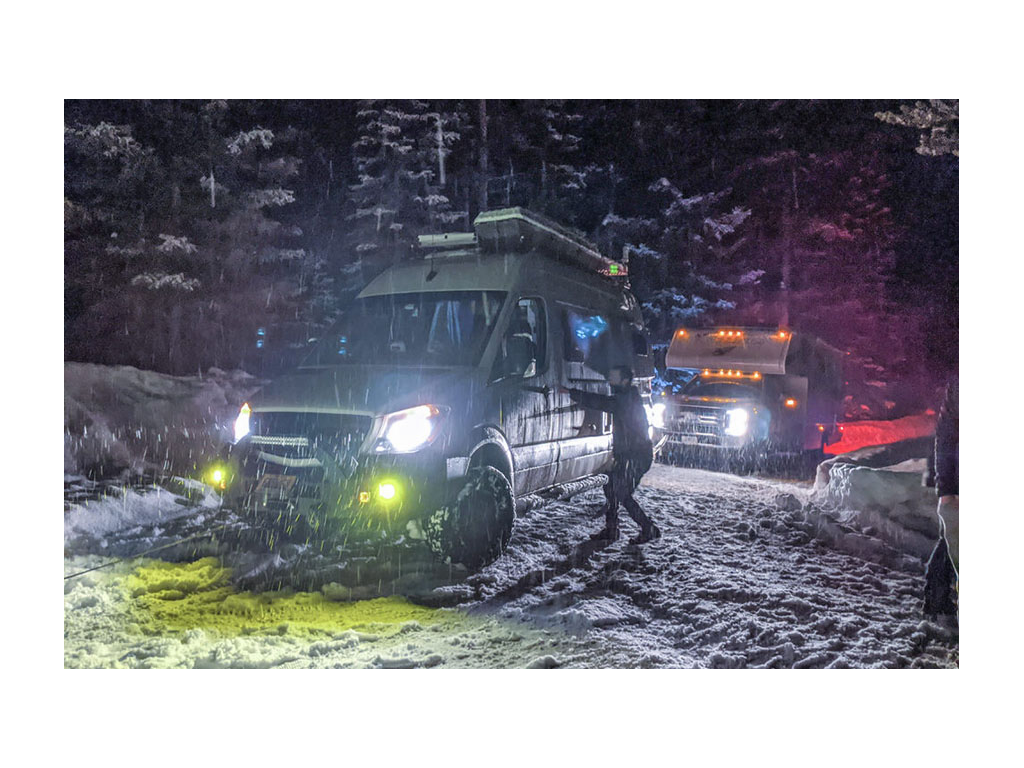
The Can-Live-Without Gear (But Great to Have!)
The items below are things we’ve added over the course of a year of long-term travel in the van, and either make life more fun or more comfortable. These might not be must-haves for everyone, but we think they are at least worth considering if you spend a lot of time in your RV.
Gear for Internet / Connectivity
- Signal Booster: One of the items we get asked most about is the external antenna mounted on our roof above our recovery tracks. This antenna is part of our cell phone signal booster system, which also includes a cable inside the van that runs to a booster and inside antenna. We debated whether we really needed this item, but it has become one of our favorite upgrades. We are continually amazed at our ability to get phone service in remote locations, which is particularly useful for on-the-go trip planning. We use a weBoost brand signal booster that runs about $500 and partially installed it ourselves, although we did get help from a professional running the cable from the roof to the interior of the van.
- Satellite Communicator: For times we can’t get cell phone service or are away from the van backpacking, we carry a satellite communication device. If you don’t put in a signal booster and plan to spend time in remote locations, we think it is worth considering the Garmin inReach Mini GPS Satellite Communicator like we have or something similar. Our Garmin cost about $350 and we pay for an annual plan that gives us the option to trigger an SOS or send a text in an emergency. We can also track our location and share the information with family and friends via a website. We’ve heard stories of others using their satellite devices to call for help with a vehicle breakdown in a location without cell phone service, so it is useful both in and outside of an RV.
Cooking Gadgets
To give us more cooking options beyond our induction stove, we carry a three-quart InstantPot and Nutribullet. We love making beans, soups, and even baked potatoes in the InstantPot and are big smoothie eaters for breakfast or lunch. We purchased a silicone mat that covers our induction stove to protect it and alternatively serve as a drying rack for dishes. (See more tips for managing meals on the road).
Outdoor Lounging
One of our most-used van items is our outdoor hammock. We purchased an inexpensive hammock for around $30 that included tree straps to better protect the bark of trees we hang it to. We’d also recommend comfy outdoor chairs for sitting around a fire or just spending time outside the RV. We love making fires, so we have assembled a robust fire kit including:
- BioLite FirePit: While most campgrounds provide a fire pit, and even lots of spots on public lands have a make-shift fire ring, we still like to carry our own fire pit. The BioLite system is designed to produce less smoke and more thoroughly burn wood, and doubles as a grill.
- Folding saw: We love our BigBoy folding saw as it cuts through large logs like butter! We camp in a lot of places that allow harvesting downed wood and this saw allows us to collect even large downed trees.
- Hatchet: We carry a small hatchet for splitting firewood, whether purchased at a campground or collected ourselves.
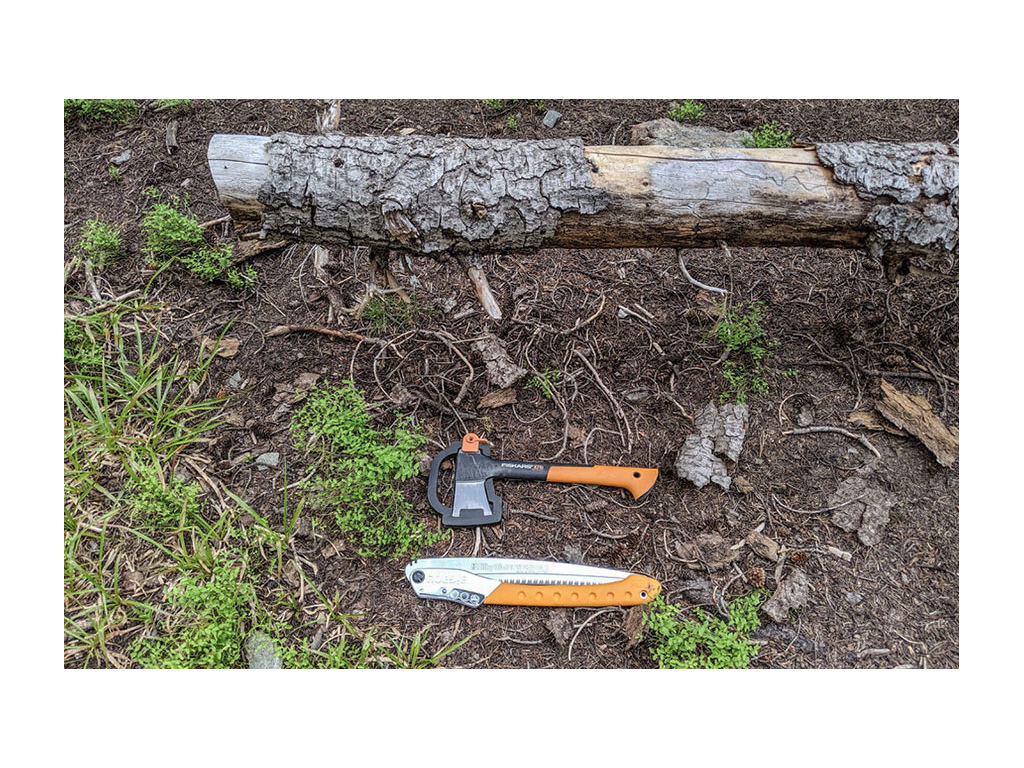
Interior Gadgets
We love gadgets, but have tried to not go overboard on cluttering up the van and instead stick to the essentials. These are some items we’ve added to the van that we think have made the biggest impact:
- Motion-activated LED lights: We’ve found it helpful to place motion activated lights by the sliding door into our van and bathroom. The lights only turn on at night, so the batteries last a long time.
- Magnetic phone mounts: Our van has USB ports above the bed we use to plug our phones in at night. To keep our phones close to the plugs so we can use short charging cables, we placed stick-on magnet mounts on the van wall. We’ve also placed mounts near other charging locations, so our phones don’t clutter up our limited surfaces in the van.
- LED string lights: We added some cozy interior string lights around the ceiling to provide some light when we don’t want our bright overhead lights on. We plugged the USB end into a USB port we have above our induction stove. The lights are held in place around the ceiling with clear 3M hooks which are barely visible. The string lights were a cheap and easy way of making the inside of the van more cheery in the evenings!
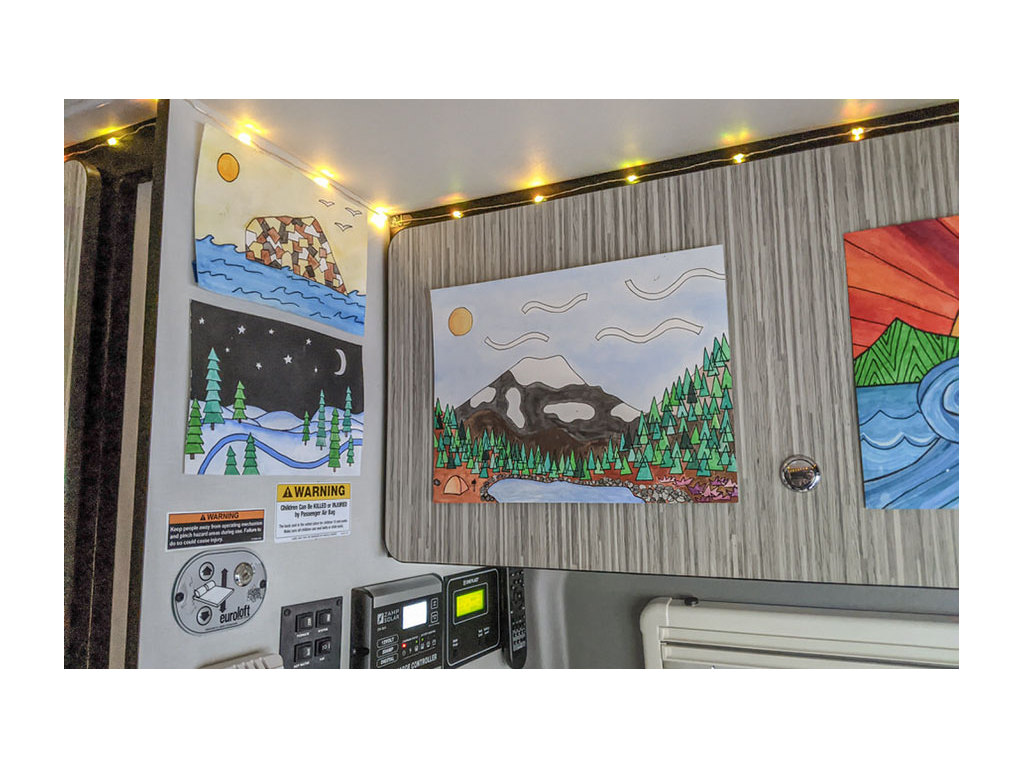
We continue to add to and refine our van gear as we meet others on the road with cool things or have moments where we think, if only we had that in the van (you can see our entire list here).
However, we’d suggest starting with the basics and not overdoing it on outfitting your RV, since a small space is often best enjoyed when clean and uncluttered. You’ll likely be surprised by how little you need to have a good time on the road!
Comments
Comments on this post are moderated, so they will not appear instantly. All relevant questions and helpful notes are welcome! If you have a service inquiry or question related to your RV, please reach out to the customer care team directly using the phone numbers or contact form on this page .